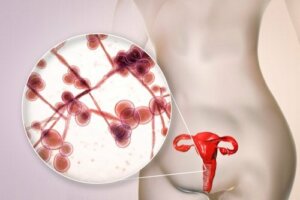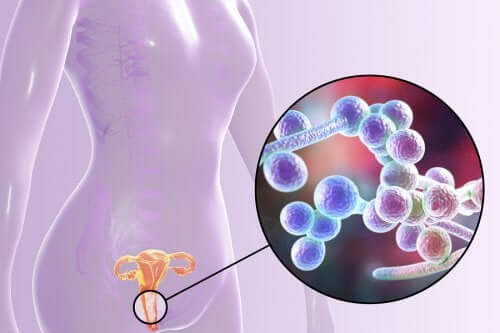Ketoconazole for Fungal Infections: Indications and Contraindications

Ketoconazole is a drug that people use to fight fungal infections. Therefore, ketoconazole is an antifungal drug. It belongs to the imidazole family, with other drugs such as clotrimazole, fluconazole, or imidazole.
This drug is orally active, although in Europe it’s only marketed for fungal infections by the topical route. This is due to the risk of hepatotoxicity. It inhibits the synthesis of corticosteroids at the adrenal level and, at higher doses, inhibits the activity of pathogenic fungi.
Some of the fungi ketoconazole is effective on are, among many others:
- Candida albicans
- Aspergillus famigatus
- Microsporum gypseum
- Malassezia furfur
As we can see, people use ketoconazole to treat Candida albicans infections, as well as those caused by other fungi belonging to this genus. They’re responsible for producing the well-known candidiasis.
Therefore, let’s start by looking at the general characteristics of this infection in order to better understand the effect of ketoconazole, as well as the properties of this drug.
General characteristics of candidiasis

The most common site of infection is the vagina. However, it can also affect other parts of the body. It usually occurs when the body’s defenses weaken and aren’t able to keep the fungi that inhabit these parts of the body under control.
On the other hand, it’s worth mentioning that 75% of women suffer from this infection at least once in their lives, and 50% of them suffer from it recurrently. It’s important to know that it’s not a sexually transmitted disease, although it can be transmitted to the sexual partner, in case of infection.
Nowadays, we have a very effective therapeutic arsenal to treat the symptoms of this infection, among which the following should be highlighted:
- Itching
- Burning sensation, especially during urination or sexual intercourse
- Vaginal rash
- Thick, white, odorless vaginal discharge
How does ketoconazole work in the body?
This drug is effective against fungal infections because it’s able to inhibit the synthesis of the fungal cell membrane. Specifically, ketoconazole inhibits the synthesis of ergosterol, which is an essential substance of the fungal membrane.
To do this, it interacts with an enzyme called 14-α-desmethylase. This enzyme is necessary in order to convert lanosterol into ergosterol. Thus, since ergosterol can’t be synthesized from lanosterol, the fungal membrane can’t be created and the fungus dies. This is how ketoconazole fights fungal infections.
Furthermore, as mentioned at the beginning of this article, ketoconazole can also affect the synthesis of corticosteroid substances. In this sense, it’s a very potent drug for inhibiting thromboxane synthesis. Doctors sometimes prescribe it orally to treat Cushing’s syndrome.
For this reason, professionals also use it to prevent adult respiratory distress syndrome, especially in patients at high risk.
Also read: Fight Fungus With These 5 Natural Solutions
Ketoconazole contraindications

When administering this drug, it’s very important to take into account the adverse reactions it may produce, as well as the situations in which doctors don’t recommend its use.
As regards contraindications, it’s a drug that requires an acid medium for its dissolution and absorption, so that in patients with achlorhydria or hypochlorhydria the antifungal can’t reach the plasma levels required to exert its effect.
In addition, the liver metabolizes it, so patients with liver damage may have their problems aggravated by the use of this antifungal.
Doctors also contraindicate its use in pregnant and lactating women. The reason for this is that it falls into pregnancy risk category C, as studies have shown teratogenic effects in animals. Breast milk excretes ketoconazole and may cause nuclear jaundice in the nursing infant.
On the other hand, as for the most common adverse reactions that this drug can trigger, we can mention the following:
- Nausea and vomiting
- Hepatotoxicity
- Decreased libido, due to its effect on hormone synthesis
- Photophobia
Learn more: Antiemetic Drugs to Prevent Nausea and Vomiting
Conclusion
Ketoconazole is a drug many doctors prescribe to fight fungal infections. Above all, specialists use it to treat candidiasis which is a disease that affects many women. And remember, candidiasis isn’t a sexually transmitted disease.
All cited sources were thoroughly reviewed by our team to ensure their quality, reliability, currency, and validity. The bibliography of this article was considered reliable and of academic or scientific accuracy.
- Espinosa-Cárdenas, P. E., Espinosa De Los Monteros-Sánchez, A. L., Mercado, M., & Sosa-Eroza, E. (2013). Ketoconazol en el tratamiento de la enfermedad de Cushing. Revista de Endocrinología y Nutrición.
- López-Ávila, K., Dzul-Rosado, K. R., Lugo-Caballero, C., Arias-León, J. J., & Zavala-Castro, J. E. (2016). Mecanismos de resistencia antifúngica de los azoles en Candida albicans. Una revisión. REVISTA BIOMÉDICA. https://doi.org/10.32776/revbiomed.v27i3.541
- Ketoconazol. (2014). In Checkliste Arzneimittel A–Z. https://doi.org/10.1055/b-0034-82520
This text is provided for informational purposes only and does not replace consultation with a professional. If in doubt, consult your specialist.








